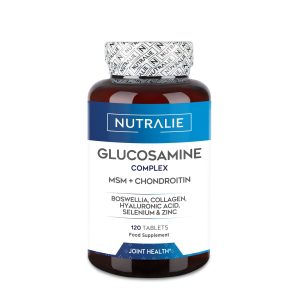Taking C are of Your Joints With Glucosamine
Glucosamine, is a commonly recommended non-vitamin dietary supplement that is used to provide relief from joint pain. It is equally popular amongst bodybuilders, power lifters and people suffering the effects of osteoarthritis.
Although weight training strengthens and builds muscle, constant stress of the cartilage can cause wear and tear. Additionally, extra muscle gained can also add extra stress to joints and cause pain. This is usually common in sports that center around high-impact cardio, as muscle strength across the joint is what stabilizes and protects it.
In any event, if you are placing regular stress upon your joints it is essential to take extra care of them in order to enjoy life (and of course, training!) to the fullest as you age.
What is Glucosamine?
Glucosamine is an amino sugar that is produced naturally in the human body. It is a combination of glucose and glutamine. Glucosamine is a key component of glycosaminoglycan polymers that are found in healthy cartilage.
Glucosamine does occur in other living organisms and throughout nature. It can also be synthesized in a laboratory. Glycosaminoglycan supplements can be taken from either source and is sometimes harvested from the shells of shellfish, or corn or wheat.
What does Glucosamine Do?
Glucosamine is plays a crucial role in the formation of glycosaminoglycans and glycoproteins in cartilage, which are essential building blocks of not only your joints, but also in tendons, ligaments and synovial fluid. Without glycosaminoglycans, your joints would not be able to repair themselves.
The bigger supply of glocusamine your body has, the more efficient it is at decreasing or eliminating joint pain caused by insufficient lubrication and inadequate shock absorption.
The Different Types of Glucosamine
There are several different variants of glucosamine, namely glucosamine hydrochloride, glucosamine sulfate and N-acetyl-glucosamine.
Although these are similar, they may not have the same metabolic effects when taken as a supplement. If a product is labelled as glucosamine, it is most commonly glucosamine sulfate. It is however, worth checking the ingredients to be 100% sure of what you are taking.
We will examine the different traits of each type of glucosamine now:
- Glucosamine Sulfate: As the name suggests, this is glucosamine that has been bound to sulfur. It is the most widely used form of glucosamine and almost always harvested from shellfish. It is the most studied form of glucosamine and recognized as the most effective on joint health.
- Glucosamine Hydrochloride (HCL): This is glucosamine bound to chlorine molecules. It is a good option for vegetarians and vegans. Most commonly it is thought that glucosamine hydrochloride is favored for its pain relieving properties while glucosamine sulfate shows better structural effects when it comes to improving cartilage health.
- N-Acetyl-Glucosamine (NAG): NAG is a unique compound is made up of glucosamine and acetic acid. This means it is an entirely different molecule from glucosamine sulfate and is absorbed differently by the body. It also provides anti-aging benefits for the skin and assists digestive health.

How To Take Glucosamine
To supplement with glucosamine, take 300 – 500 mg three times daily. Your daily total should not exceed 900 – 1,500 mg. Glucosamine should always be taken with food. This method of supplementation will minimize the risk of stomach upset.
Glucosamine sulfate is often taken with chondroitin sulfate. (Chondroitin sulfate is a larger molecule that is used to make cartilage, bones, ligaments and tendons). The typical dose is 1500mg daily of glucosamine sulfate and 1200mg of chondroitin sulfate.
While we do not recommend it, studies have suggested that doses as high as 3,000 mg daily may be able to slow joint degradation for athletes who train in high impact sports. It is generally thought that glucosamine is safe, up to 2,000 mg per day.
Is Glucosamine Safe?
Glucosamine is very safe and its most common side effect is flatulence. It may however cause very mild side effects in some users.
These can include:
- Skin rashes
- Headaches
- Stomach Upsets
- Diarrhoea
- Constipation
If any of these effects are encountered, merely stop taking glucosamine and the symptoms will subside.
Diabetics that choose to take glucosamine will need to monitor their blood sugar levels carefully as there may be some interaction between anti-diabetic medication and glucosamine. The interaction between the two medications is not large, however if you are diabetic it is worth discussing glucosamine with your doctor prior to commencing treatment.
There have been reports of interactions between glucosamine and chemotherapy drugs and also between glucosamine and drugs that lower blood cholesterol. If you are undergoing chemotherapy or suffer from high blood cholesterol it would be prudent to consult with your doctor.
Because glucosamine is sometimes sourced from shellfish, people who are allergic to seafood should take the shellfish-free variety.

Anything Else To Know?
While glucosamine has been proven to be effective in reducing joint pain over several clinical studies, some users will find it only provides mild relief. If you fall into this category you have several other options available to you, including turmeric and ibuprofen. Of course any persistent join pain should be discussed with your doctor and an effective treatment implemented.
It is interesting to note that all studies into the effectiveness of glucosamine have involved people suffering from osteoarthritis and no clinical trials have been conducted on healthy people that aren’t showing symptoms of OA.
However it is a natural compound and a very safe supplement. It is useful in both a preventative capacity and also when recovering from a joint injury.



Thank you! Very helpful